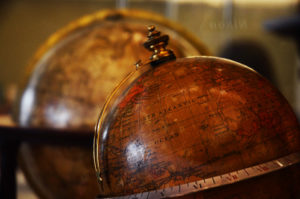By Ben Theriault, Staff Writer
The Osher Map Library and Smith Center For Cartographic Education at USM holds tens of thousands of rare and historical maps, making it the second largest collection of publicly available maps in the country.
This semester, the map library attempted to broaden its student and faculty reach. Under the instruction of the library’s executive director, Libby Bischof, and professor in the History of Cartography, Matthew Edney, one thousand dollar fellowship grants were distributed this past November to professors that wanted to incorporate the map library into their classes with help of generous donations from the Friends of the Osher Map Library. This year, seventeen grants were claimed from professors in a plethora of disciplines.
The library is currently hosting two art classes, Kim Bentley’s Art 232: Introduction to Ceramics and Andrea Sulzer’s Art 151: Fundamentals of Perceptual Drawing. Both of these professors are using the maps that are meticulously curated by Bischof and Edney to inspire their students’ work.

Bentley and Sulzer each hope their students will gain something unique from the experience. Bentley stated that she hopes these maps will encourage students to think critically and in-depth about their own history. She believes that this is a distinct opportunity for her students to know Maine more intimately.
“It is allowing students the chance to get ‘hands-on’ with their own history and culture and to get inspired by the beauty of these maps,” said Bentley. “They can choose to study maps that interest them culturally, politically, religiously, etc. The possibilities are endless.”
Bentley sees a lot of importance in the marriage of history and art. “I always stress to my students that art does not get made in a vacuum,” Bentley said. “When looking at art we have to take into account the historical time period in which it was made.” By thinking about history critically, she believes students will be able to bestow their work with greater meaning.
Sulzer hopes to use the maps in more literal ways. She hopes that studying these maps will “broaden students sense of drawing as a means for visual communication,” and influence students to “think of spatial relationships a bit differently” when structuring their drawings. By analyzing the historical value of maps she believes she can demonstrate the connection of drawing to its broader functions in society.
Bischof hopes that these grants will be taken advantage of and bring traffic to the library. Currently, around 500 USM students and 3,000 local K-12 students visit the library a year. She is optimistic that these numbers will rise as students and faculty become more comfortable with the collections.
Despite these numbers, many people are unaware of the collections existence. Bentley admitted herself that she had not actually heard of the library until receiving an email about the grant. Through these fellowships, Bischof hopes to peak the curiosity of other professors and continue exposing more and more students to the collection. Ultimately, she wants students to feel comfortable enough to consult the library as a source for personal research.
These maps have the ability to promote an unexpected sense of introspection and connection to one’s surroundings. According to Sulzer, “it is not just an assignment, they are looking at their own heritage and hopefully thinking more about the world.”
The Osher Map Library is open from 10 a.m. to 4 p.m. Tuesdays through Fridays, and Saturdays from 10 a.m. to 2 p.m.

